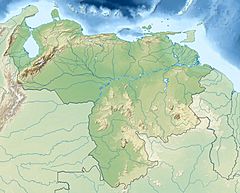"Cochranella" riveroi facts for kids
Quick facts for kids "Cochranella" riveroi |
|
|---|---|
| Conservation status | |
| Scientific classification | |
| Genus: |
"Cochranella"
|
| Species: |
riveroi
|
| Synonyms | |
|
|
"Cochranella" riveroi is a tiny frog that belongs to the Centrolenidae family. These frogs are often called "glass frogs" because some of them have clear skin. This special frog is only found in one place: Cerro Aracamuni in Venezuela.
Contents
About the Cochranella riveroi Frog
This small frog is quite unique. It was first discovered and described in 1992. Scientists gave it the name Centrolenella riveroi back then.
Why Its Name Changed
Later, after more studies, most scientists decided that this frog fit better into a different group, or genus, called Cochranella. So, its scientific name became Cochranella riveroi. Even today, scientists are still studying exactly where this frog fits in the frog family tree.
What Does Cochranella riveroi Look Like?
These frogs are quite small. Adult males are about 21 to 22 millimeters long. That's about the size of a small fingernail! Females are a bit bigger, around 25 millimeters long.
Key Features
- They have a visible tympanum, which is like an eardrum.
- Their fingers have a little bit of webbing, and their toes have more webbing.
- Their skin on their back feels bumpy or "granular."
- Scientists don't know what colors these frogs are when they are alive. All the information comes from preserved specimens.
Where Does Cochranella riveroi Live?
This special frog lives only on the very top of Cerro Aracamuni. This is a mountain in Venezuela. It's a type of flat-topped mountain called a tepui.
Its Mountain Home
The frogs were found living in bromeliad plants. These plants grow on the mountain summit, which is about 1,600 meters (or about 5,250 feet) above sea level. The plants on top of the mountain are mostly short, less than 1 meter tall. There are also small forests in dips and along streams.
Protecting Cochranella riveroi
Currently, scientists don't know of any big threats to this frog. However, because it lives in such a small area, it is considered vulnerable. If something were to happen to Cerro Aracamuni, this frog could be in danger.
Luckily, Cerro Aracamuni is part of the Serranía de la Neblina National Park. This park helps protect the frog's home and the unique environment of the tepui.



